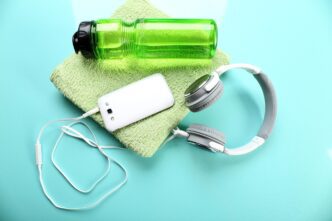For anyone striving for a leaner physique, the desire to target fat in a specific area—most commonly the abdomen—is a powerful motivator. This concept, known as “spot reduction,” fuels countless workout programs and fitness gadgets promising to melt away belly fat with targeted exercises like crunches and sit-ups. The science, however, tells a different story: it is physiologically impossible to choose where your body loses fat. Fat loss is a systemic process, meaning that when you lose fat, you lose it from all over your body in a pattern predetermined by genetics and hormones, not by the specific muscles you choose to exercise.
Understanding the Myth of Spot Reduction
The theory behind spot reduction seems intuitive. If you work a specific muscle group, your body must be burning the fat stored directly on top of those muscles for energy, right? This logical-sounding premise is why so many people spend hours performing abdominal exercises, hoping to reveal a chiseled six-pack.
Unfortunately, the body’s energy systems don’t operate with that level of precision. The fat stored in your cells, known as adipose tissue, is not directly linked to the muscles underneath it. It’s part of a whole-body energy reserve system.
When you exercise, your muscles send out a signal that they need energy. Your brain and hormonal systems respond by releasing fat-mobilizing hormones, such as adrenaline and noradrenaline, into your bloodstream. These hormones travel throughout your entire body, signaling fat cells to release their contents.
These contents, called fatty acids, are then transported through the bloodstream to the muscles that need them for fuel. Your body doesn’t preferentially pull fatty acids from the cells closest to the working muscle; it pulls them from its total fat stores across the body, including your arms, legs, back, and, yes, your abdomen.
The Science of How Your Body Loses Fat
To truly grasp why spot reduction fails, it’s essential to understand the mechanics of fat metabolism. Your body composition is a result of energy balance—the relationship between the calories you consume and the calories you expend.
Energy Storage and Release
Fat is stored in specialized cells called adipocytes in the form of triglycerides. To be used as fuel, these triglycerides must be broken down into their components: glycerol and three fatty acid chains. This process is called lipolysis.
When you are in a caloric deficit, meaning you are burning more calories than you are eating, your body initiates lipolysis to make up for the energy shortfall. The released fatty acids enter the bloodstream and are shuttled to the mitochondria—the powerhouses of your cells—to be converted into usable energy.
This process is governed by your overall energy needs, not localized muscle activity. While exercising your abs burns calories, the energy demand is met by fat stores from all over your body, not just your belly.
The Role of Genetics and Hormones
Where your body tends to store fat first—and lose it last—is largely dictated by factors outside of your control, namely your genetics, sex, and hormonal profile. Some people are genetically predisposed to storing more fat in their hips and thighs (a “gynoid” or pear shape), while others store it primarily in the abdominal region (an “android” or apple shape).
Hormones play a significant role as well. For example, high levels of the stress hormone cortisol are strongly linked to increased storage of visceral fat—the dangerous type of fat that surrounds your internal organs in the abdominal cavity. This is one reason why chronic stress can contribute to belly fat accumulation.
What the Research Conclusively Shows
The scientific community has investigated the concept of spot reduction for decades, and the consensus is clear. Study after study has failed to show any meaningful effect from targeted exercise on localized fat stores.
One classic study from the 1970s examined the arms of professional tennis players. Researchers measured the subcutaneous fat on both the players’ dominant and non-dominant arms. Despite the dominant arm being significantly more muscular from thousands of hours of use, there was no significant difference in the thickness of the fat layer between the two arms.
More recently, a 2011 study published in the Journal of Strength and Conditioning Research had participants perform an intensive abdominal exercise routine for six weeks. At the end of the study, researchers found no significant reduction in belly fat or abdominal circumference compared to a control group that did no exercise. The exercise group did, however, improve their muscular endurance.
A 2013 study provided some nuance. It found that performing exercise with one leg did lead to slightly more localized fat breakdown in that leg compared to the resting leg. However, the researchers concluded that the overall effect on fat mass was “trivial” and not enough to make a practical difference in one’s appearance.
The Real Strategy for Losing Belly Fat
If you can’t spot-reduce fat, what is the effective approach? The answer lies in a comprehensive strategy focused on reducing your overall body fat percentage. When your total body fat decreases, your belly fat will decrease along with it.
1. Create a Sustainable Caloric Deficit
The non-negotiable foundation of all fat loss is consuming fewer calories than your body expends. This forces your body to tap into its stored fat reserves for energy. A moderate deficit of 300-500 calories per day is a sustainable starting point for most people, leading to a safe and steady rate of fat loss.
Focus on a diet rich in whole, nutrient-dense foods. Prioritize lean protein, which helps preserve muscle mass and increases satiety, making it easier to stick to your calorie goals. Fill the rest of your plate with high-fiber vegetables, fruits, and complex carbohydrates, along with healthy fats.
2. Prioritize Full-Body Strength Training
While crunches won’t melt belly fat, a consistent strength training routine is your most powerful tool for changing your body composition. Lifting weights builds lean muscle mass, which is metabolically active tissue. The more muscle you have, the more calories your body burns at rest, effectively raising your basal metabolic rate.
Focus on compound exercises that work multiple muscle groups at once, such as squats, deadlifts, overhead presses, and rows. These movements are highly efficient, burning more calories during the workout and providing the greatest stimulus for muscle growth and metabolic enhancement.
3. Incorporate Cardiovascular Exercise
Cardio is an excellent tool for increasing your overall calorie expenditure and improving heart health. A combination of different intensities can be highly effective.
Moderate-Intensity Steady-State (MISS): Activities like brisk walking, jogging, or cycling for 30-60 minutes help burn a significant number of calories and are sustainable over the long term.
High-Intensity Interval Training (HIIT): This involves short bursts of all-out effort followed by brief recovery periods. HIIT is extremely time-efficient and can boost your metabolism for hours after the workout is over, an effect known as excess post-exercise oxygen consumption (EPOC).
4. Manage Lifestyle Factors: Sleep and Stress
Your efforts in the kitchen and the gym can be undermined by poor lifestyle habits. Chronic sleep deprivation and high stress levels wreak havoc on the hormones that regulate fat storage.
Aim for 7-9 hours of quality sleep per night. Poor sleep elevates cortisol and ghrelin (the hunger hormone) while suppressing leptin (the satiety hormone), creating a perfect storm for overeating and fat gain, particularly in the midsection.
Find healthy ways to manage stress, such as mindfulness, meditation, yoga, or spending time in nature. Actively managing your stress can help lower cortisol levels and reduce the hormonal drive to store belly fat.
The True Purpose of Core Exercises
This does not mean you should abandon core exercises like planks, leg raises, and crunches. These movements are incredibly valuable—just not for burning belly fat.
Their true purpose is to build and strengthen the underlying abdominal muscles, including the rectus abdominis (the “six-pack” muscles), the obliques (the muscles on your sides), and the transverse abdominis (your deep, internal core muscle).
A strong, well-developed core is essential for stabilizing your spine, improving posture, preventing lower back pain, and transferring power efficiently during athletic movements. And, once you have successfully lowered your overall body fat percentage through diet and full-body exercise, these strong, defined muscles will be revealed.
Ultimately, the quest for a flat stomach is not won through thousands of crunches but through consistency and a holistic approach. While the myth of spot reduction is an appealingly simple solution, the truth is that lasting results come from embracing a comprehensive lifestyle change. Focus on nourishing your body with whole foods, building strength through compound exercises, moving your body regularly, and prioritizing sleep and mental well-being. By shifting your goal from “losing belly fat” to “improving overall health and reducing body fat,” you will not only achieve the aesthetic you desire but also build a stronger, more resilient body for life.







